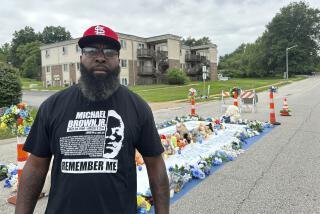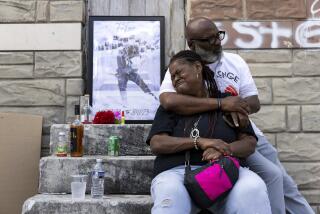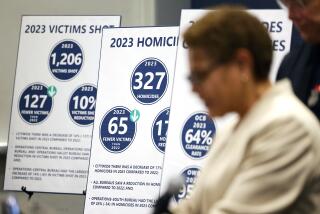St. Louis Activists Struggle to End Violence’s Toll on Young Black Men
- Share via
ST. LOUIS — Baqi Cherry has felt the cold, hard barrel of a gun at his head and has seen bloody, violent death up close.
“The easiest way out is to sell drugs in my community. I did it to survive. I sold drugs to feed myself,” said Cherry, 19, who has survived life on the streets of America’s deadliest city for young black men. “It wasn’t until I got in the group that I found out there are other ways to get by.”
“The stuff that he’s been through--this kid could have given up a long time ago. He would have been a homicide statistic, no doubt in my mind,” said Police Capt. Charles Alphin, who leads “the group” Cherry joined.
Alphin formed the Dr. Martin Luther King Jr. St. Louis Youth Support Group two years ago to help black teen-agers find alternatives to violence that are not preachy or sissy, that they can use and “still be cool.”
The 35 to 40 teen-agers meet each week in a classroom in Alphin’s station house to talk about ways that nonviolence can work in their everyday lives, which are spent in neighborhoods where death, drugs, guns and gangs are not uncommon.
Young black men in St. Louis are being killed at a higher rate than in any other large city, statistics show. A recent study by the Missouri Department of Health concluded that without change, one out of every 13 black males in St. Louis who are now 15 will be killed before age 45.
Cherry can count friends and relatives among those statistics. He has come close, but with the help of “the group,” he is a believer in nonviolence.
Today Cherry, who graduated from high school in May, is working evenings at a bank. He is engaged to be married and plans to start college part-time in January. He wants to be an engineer, or maybe a teacher.
Alphin’s is one of many efforts aimed at reducing the deadly toll. In 1985-87, the murder rate for black men aged 15 to 44 was 258.8 per 100,000 people--21.2% higher than Detroit and more than 130% higher than Washington.
While the high rate was alarming to many, the composite of the typical victim was not surprising to anyone who reads the daily paper, where killings on the predominantly black North Side often are noted in a few quick paragraphs.
The typical victim: a man between 20 and 34, shot to death during an argument at night within a mile of his north St. Louis home. The killer: a black male acquaintance, 20 to 29 years old.
Unemployment, drugs, inadequate housing and lack of education are cited by those who try to find the reason for St. Louis’ epidemic.
But Detroit, Washington and other major cities experience the same social ills. What makes St. Louis different?
Part of the answer may be found in another study.
University of Chicago researchers this year reported that St. Louis was one of 10 “hypersegregated” cities, with multiple forms of segregation affecting only blacks. The others are Chicago; Baltimore; Cleveland; Detroit; Gary, Ind.; Los Angeles; Milwaukee; Newark, N.J., and Philadelphia.
The result for blacks is isolation from amenities, opportunities and resources, making it more difficult for them to get ahead in life.
“It may be that we have a disproportionate amount of people who feel that they are particularly locked out of the system,” said Alphin, who is black. To dissolve that polarization, local government, business, religious and activist leaders need to coordinate an attack on those barriers, he said.
“I think it has to be a regional approach. Black people can’t solve this problem by themselves. They didn’t create it. They certainly can’t solve it by themselves.”
Some officials are quick to point out, however, that statistics can mislead, and that St. Louis would have fared better in the health department’s study had the researchers looked at the decade as a whole.
“You take New Orleans or Washington, D.C.,” said Bill Kuehling, a spokesman for Mayor Vincent Schoemehl. “We may surpass them some years and they may surpass us some years. But you look at the major urban areas, they’re all going to bounce around within the same ranges.”
Homicide totals in the last decade have ranged from a high of 265 in 1979 to a low of 128 in 1984, said William Peth of the St. Louis Police Department. In 1985-87, the totals were 169, 195 and 153. Last year, there were 140.
In Detroit, there were 636 homicides in 1985, 648 in 1986, and 686 in 1987. Washington tallied 148 homicides in 1985, 197 in 1986 and 228 in 1987.
Nonetheless, in the aftermath of the survey, the health department formed a study group to plan a community-wide conference on black homicide.
“We feel that a major emphasis needs to be made in terms of education, employment and housing. Those three things are critical to general peace of mind,” said Paul Saunders, the department’s district administrator. And beyond that, he said, the group intends to keep the issue from fading.
“We have to continue to pick the conscience of America, white and black. It’s not a black problem, it’s not a white problem. It’s an American problem.”
More to Read
Sign up for Essential California
The most important California stories and recommendations in your inbox every morning.
You may occasionally receive promotional content from the Los Angeles Times.










